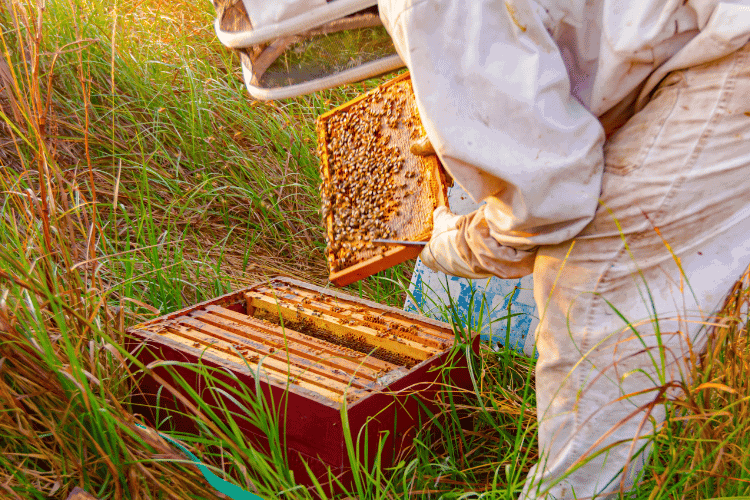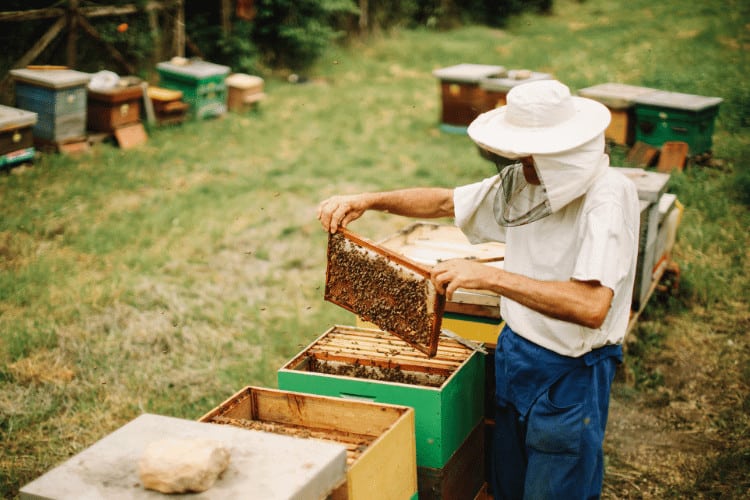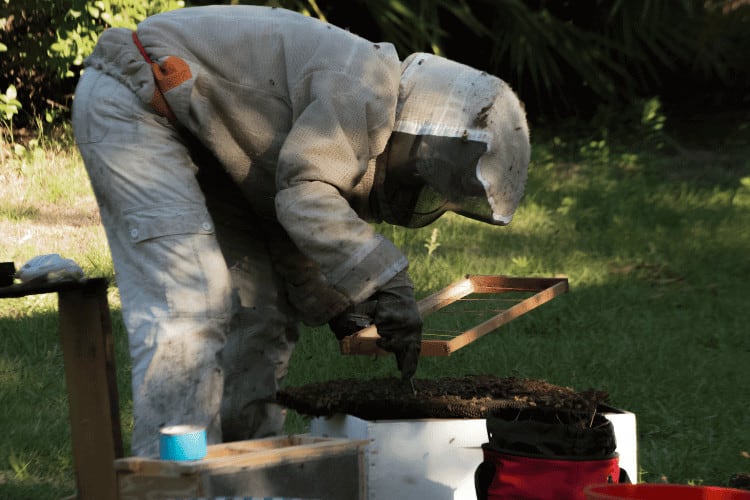DIY Beehive Plans
Creating DIY beehive plans using readily available materials is a cost-effective solution for beekeepers seeking to expand their bee colonies. I find joy in putting unused materials to good use while incorporating a creative touch into my beehive projects.
However, you must consider factors like bee colony size, material durability, and ventilation in building a healthy and comfortable environment for your bees.
With that in mind, you can turn DIY beehive plans into an income-generating hobby. The secret is having the right tools, materials, and instructions.
With years of beekeeping experience, I listed some of the best DIY beehive plans that worked for me; and you can do it too!
What are the Factors to Consider When Making a DIY Beehive Plan?

Before you gather materials and start tinkering on your DIY beehive projects, here are essential considerations you should take into account:
1. Beehive Size and Type
First, you need to identify the size and type of beehive you want to create. It should be enough to accommodate the colony. You should also consider your yard space.
At the same time, there are many different types of beehives to consider. Some offer the advantage of easy handling due to removable sections.
Another element to consider when choosing beehive types is the availability of insulation. Honey production depends on the type of beehives too.
2. Material Type, Quality, and Weight
You need to consider the materials you’ll use for construction to ensure a comfortable environment that’ll help your bees thrive. These materials should be non-toxic, durable, breathable, and resistant to elements.
Additionally, keep in mind the weight of the material. Boxes or beehives can get heavy once loaded with bees or honey. Therefore, using wooden material that’s way too heavy can make handling quite tricky.
Finally, note the fact that honeybees can be quite picky with the type of wood that they accept as a habitat, too. Here are some of the most commonly used and honeybee-approved types of wood:
- Cypress
Cypress wood is highly durable with natural preservatives and insect-repelling properties (thanks to its sap!)
The only disadvantage is they can be a bit pricey.
- Cedar
This wood type is lightweight, durable, and easy to work with; hence, the hefty cost.
What makes this wood type stand out is the fact that it’s rot-resistant. Additionally, the Western red cedar is the widely-used type.
- Pine
This material is by far one of the most commonly used and cheapest ones you’ll ever find.
One example is the clear grade type, which is excellent for building hives. However, it may not be as durable as other wood types, so they need extra protection to preserve them from weather damage.
- Fir
Another highly durable wood option is fir, which makes a strong beehive lumber that doesn’t warp easily. They’re also less dense, making them less prone to chipping.
3. Tools and Equipment
Building beehives from scratch is no easy task—especially if you’re working with lumber. Expect tons of cutting, sewing, gluing, and screwing!

Given that fact, you might need more than just a hammer and chisel. Depending on the beehive plan, you might need tools like table saws, drills, dado stacks, etc.
4. Protective Coating
It would be best to layer your hive with a protective coating to protect it from elemental damage, wood rot, and warping. Here are some products you can use:
- Stains
For an aesthetically pleasing appeal, you can coat your DIY beehive with stain. The stain also repels ultraviolet rays and water.
- Tung oil
Using additive-free tung oil to coat your beehive is an excellent method to waterproof it. To do so, add multiple layers of tung oil to your hive, allowing it to dry for up to 24 hours before adding a new coat.
It’s best to let your tung-oil-coated hive cure for up to a month for the best results.
- Wax
Coat your hive with wax for increased protection against water, snow, and sunlight. Ideally, beeswax makes an excellent hive coating.
- Paint
Use natural or water-based paints with little to zero volatile organic compound content to coat your wooden hives. White paint also helps with temperature regulation by reflecting sunlight and minimizing heat.
What Types of Beehives are Good for DIY?
We narrowed our search down to the three most popular beehive plan options as well as their advantages and disadvantages:
1. Langstroth Beehive
First developed in the 1850s, the Langstroth beehive is currently the most commonly used type in the US.
This beehive type features removable, vertically hung frames, with the entrance at the base or bottom board.
Langstroth hives come in three depths (deep, medium, and shallow), and you can opt for an eight- or ten-frame. A ten-frame hive is heavier but ideal if you want more room for honey.
Pros and Cons
Langstroth beehives allow easy maintenance and excellent honey yield. Accessories and components are also easy to find, especially for the ten-frame type.
One disadvantage is that the hive design doesn’t allow the bees to produce honey naturally. They’re pretty heavy, too, so transfer and harvest can be quite challenging.

Inspection can be invasive as well.
2. Top Bar Beehive
The Top Bar beehive features a horizontal long box design that doesn’t utilize frames, so honey bees build their own comb along the bars that hang along the hive cavity.
The hive is made up of three basic components like box, bars, and the top.
Pros and Cons
The hive helps lessen back strains because of its legged design. It’s cheap to build and doesn’t require heavy lifting, similar to Langstroth hives.
However, the Top Bar hive isn’t beginner-friendly, and it’s not the best option if you want excellent honey produce. You must also harvest your combs or honey regularly to prevent the colony from swarming.
3. Warre Beehive
The Warre hive features a house-like design with a sloped roof to protect the bees from elements and layers of boxes. It combines the features of Langstroth and top bar hives.
With this design, bees build their own honeycombs through the wooden bars.
The design also allows better temperature regulation, with its ventilation gap just below the roof and a quilt box that wicks moisture out.
Pros and Cons
One of the advantages of a Warre hive includes harvesting an entire box, unlike per-frame harvesting, that’s time-consuming. Since the design for Warre beehives isn’t standardized, monitoring colony activity can be challenging for hives with no windows.
What Are the Best DIY Beehive Plans to Consider?
I list some of my favorite DIY beehive plans and tutorials which I found helpful in building my beehives from scratch:
Langstroth Beehive Plans
Here are some easy-to-follow DIY plans for building Langstroth beehives:
This beginner-friendly DIY beehive plan from the Family Handyman magazine requires only six tools.
It also includes a video guide you can reference while building your version of the hive.
What I love most about this DIY plan is it includes a step-by-step plan with images for every step and a diagram for cutting measurements.
It also has illustrations for every beehive part along with measurements for better visualization and comparison of dimensions.
2. How to Build a Simple Horizontal Beehive
Learn how to make a budget-friendly langstroth beehive with this YouTube video. If you’re a visual learner like me who prefers video tutorials, this easy-to-follow guide is worth the watch.
Even those with no shops at home can easily follow through with this DIY beehive plan.
Top Bar Beehive Plan
Check out this amazing top bar beehive plan you can try in the comforts of your home:
This top bar beehive plan shares detailed building instructions, including recommendations on alternatives in case you don’t have the mentioned material or tool.
The best part is that you won’t need a well-equipped workshop to try this beehive plan!
Warre Beehive Plans
Make your beehive using tools you can find at home! Here are Warre beehive plans worth trying:
1. Warre Hive Construction Guide
As someone who doesn’t have complicated construction equipment at home, I find this guide most helpful. Every process is easy to understand, with photos to back it up.
This guide also includes safety and construction tips that are useful for beginners.
2. How to Build a Warre Beehive
This guide is specific for building a Warre beehive with 300 x 300 x 210 mm internal dimensions. It focuses on building every component of the hive.
Frequently Asked Questions (FAQs)
What is the easiest beehive to build?
Due to their simple structure, Warre and Langstroth beehives are the simplest to build.
What is the cheapest DIY beehive?
Warre beehives are the cheapest DIY hive you can build. In fact, you can build one with a 50-100 dollar budget.
What is the best wood for beehives?
Considering affordability, availability, and strength, pinewood is the best and most preferred lumber for beehives.
Conclusion
When building your beehive from scratch, consider the beehive type and the durability of the material you’ll use. It should be non-toxic and resistant to elemental damage.
At the end of the day, your top priority is still building a healthy and comfortable space that can accommodate your colony.
Meanwhile, you don’t need a fully-equipped workshop to build your DIY beehive. Our beehive plan compilation includes designs you can build with basic tools readily available at home.
